How to Start a YouTube Channel in 2024 (Ultimate Guide)
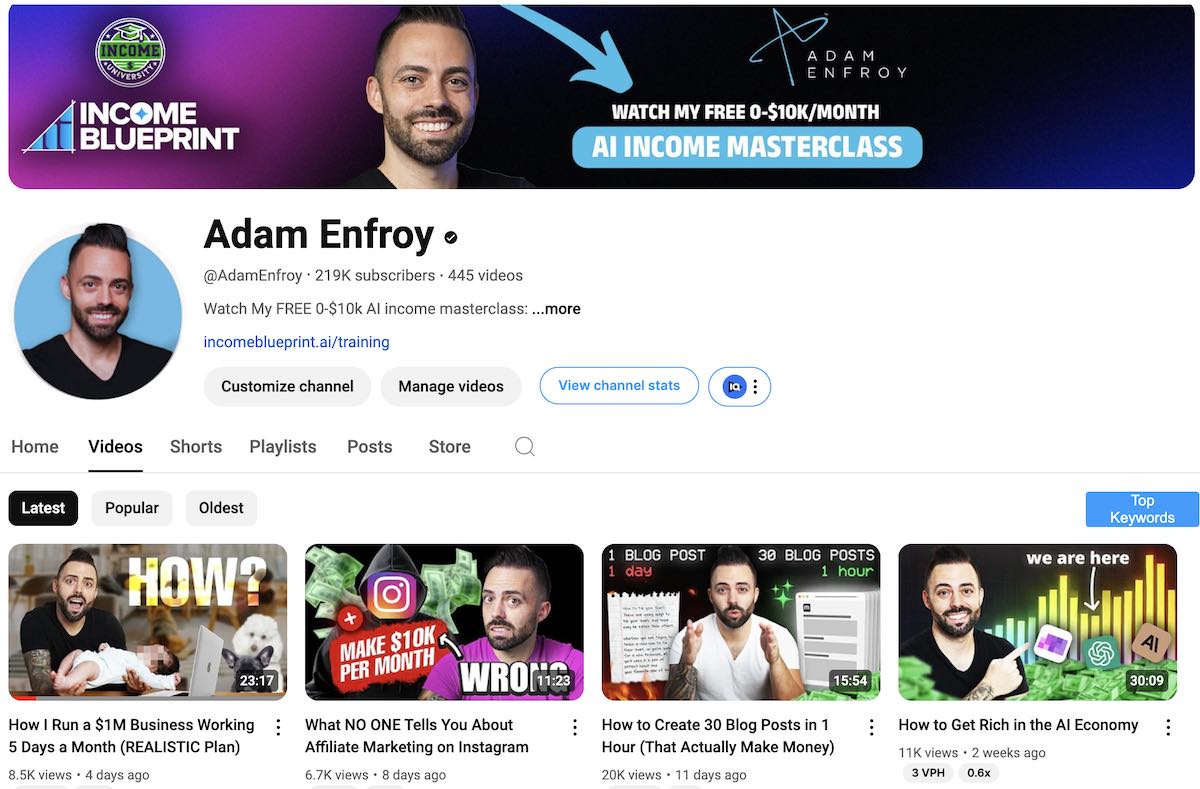
If you’re looking to start a fun and profitable YouTube channel – you’ve come to the right place.
I started my YouTube channel in 2021 and have grown it to over 200,000 subscribers and over $1M/year in revenue from ads, affiliate marketing, and course sales.
YouTube, in my opinion, is the #1 platform to build an audience of raving fans today.
And you don’t need to go super viral to make a living on YouTube.
You just have to treat it like a real business.
So before making famous YouTuber money, you have to set up your channel. One step at a time haha.
In this guide, I’ll cover how to start a YouTube channel this year, from setting up your channel and customizing it, to your video strategy, monetization, and more.
Let’s get into it.
Step by Step: How to Start A YouTube Channel
Here are the steps to start a YouTube channel.
Step 1. Create Your Channel With Google.
You can use your Google account to set up your channel on YouTube. You do not need a specific phone or computer, just follow these simple steps, and you should be ready to go.
First and foremost, sign in to YouTube with your Google account.
Head to YouTube.com and click on the “Sign In” option, after which you’ll get prompted to enter your Gmail Id and password.
If you already have an account with YouTube (which you most likely have), click on your user icon from the right-most corner of your screen. Then hit the “Settings” option from the drop-down menu.
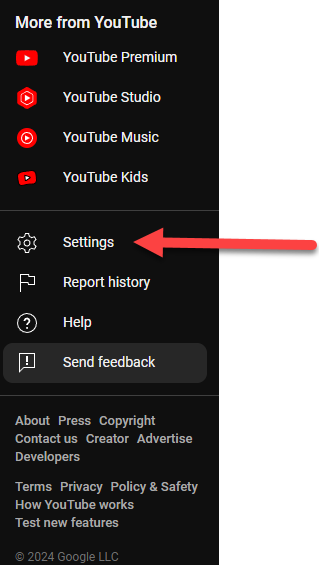
Since Google owns YouTube, the above drop-down menu is for your Google account as well as your YouTube account.
Next, you’ll get redirected to your account overview. Select the “Create a new channel” link under the “Your YouTube channel” tab.
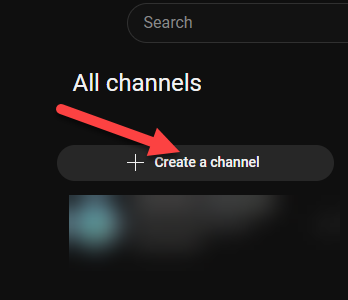
The first step to starting a YouTube channel is creating your channel name.
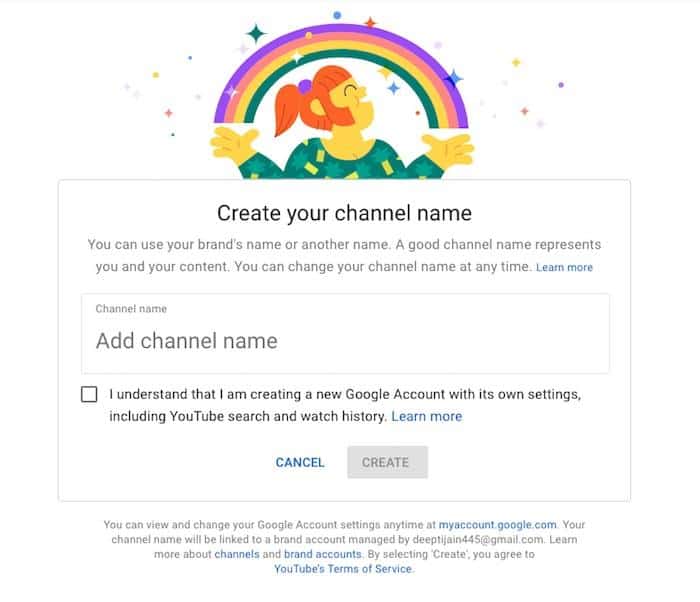
You can use your brand’s name or another name.
Step 2. Create Your Channel Name.
Your channel name is vital for success on YouTube. It’s your business card because it tells users who you are and what your video channel will be about.
There are more than a million YouTube channels out there, and that number is growing every day. To make your channel stand out in the crowd, your name should be both searchable and unique.
A good YouTube channel name has the potential to get more views, subscribers, likes, and shares.
Consistency with your name is another crucial factor in building your brand. So, if you’re already a famous influencer and your name is your major draw, it’s a good idea to keep your own name for your YouTube channel.
For instance, I already run a significantly well-known eponymous blog. And I chose to use my own name as the name of my YouTube channel now that I’m foraying into YouTube to share video tutorials on “how to build a successful blogging business.”
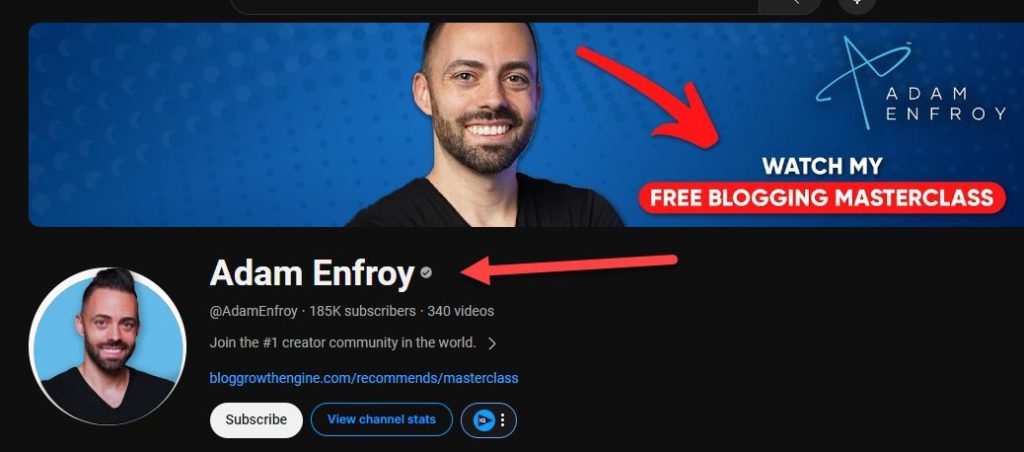
Here are other tips to consider while choosing your channel name:
- Choose a channel name that’s easy to remember.
- Pick a name that resonates with a unique audience.
- Make it relevant to your niche.
- Your YouTube channel name is case-sensitive, so make sure to use capitals to make it more readable.
While how your viewers engage with your content is the most crucial part, a memorable name can certainly help.
Make sure to take your time and fully brainstorm what you want your audience to know you as. And since YouTube lets you change your channel name in the future, you can proceed with a temporary name for now.
Step 3. Customize Your Channel.
After you pick your channel name and select the “Create” option, you’ll get redirected to your final channel page. You can now begin uploading your videos right away.
However, you have to customize your channel and upload your channel art first.
Select the “Customize Channel” option to begin customizing your channel.

Customizing your channel is where the real work comes.
Channel customization has three major categories:
- Layout – The layout section will help you present your video content in the best possible light.
- Branding – This includes uploading your profile picture, banner image, and video watermark.
- Basic Info – Add your channel name, description, URL, and links to the sites you want to share with your viewers.
Let’s customize all of these elements one at a time, starting with the Basic Info.
1. Add Basic Info.
Begin by clicking on the “Basic Info” section.
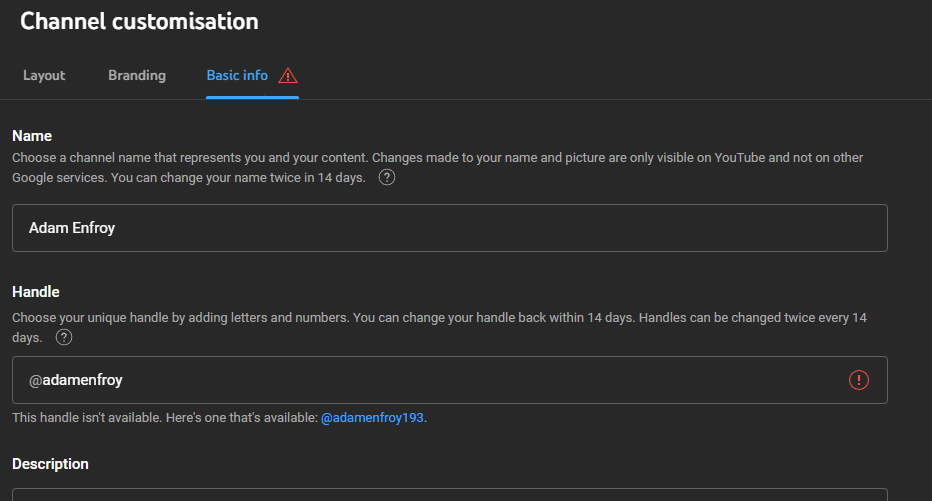
The Basic Info section will let you add your channel description, links to other sites, contact info, and more.
Your channel description will appear in the About section of your channel and search results and is likely to be one of the things your viewers see. And not just YouTube search results, it will also appear in Google search results.
It should represent who you are, your personality and give your audience an idea of what to expect from you as a YouTuber.

Next, you have your channel URL that is the standard web address for your channel. Your original URL will include your unique channel ID.
If you want a professional-looking YouTube channel, I suggest taking some time to customize the default channel URL.
However, you need to have 100 or more subscribers and be at least 30 days old to claim a custom URL.
Once you’re eligible for a custom URL, you’ll get notified via email and even see a notice in your basic info setting. You may also get notified in your Channel dashboard.
You can also redirect viewers to your other channels by adding links. The links you add will appear over your banner at the bottom.
2. Add Branding Elements.
Now it’s time to add branding elements (channel art) to your channel, namely your profile picture, banner image, and video watermark.
You can add all of these elements under the “Branding” section.
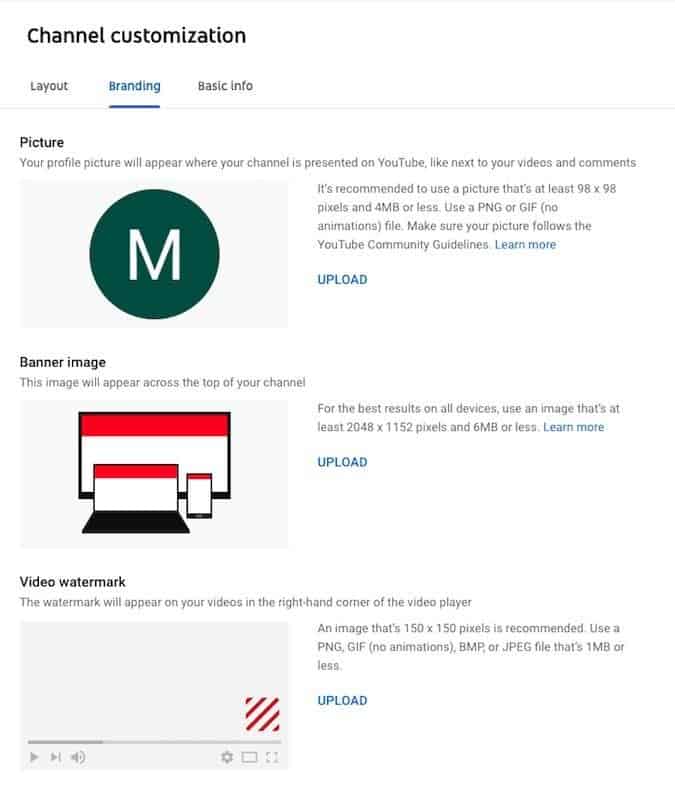
Profile Picture.
Your YouTube profile picture is an excellent opportunity for you to engage with users, create a first impression, and showcase your brand. The profile picture gets displayed everywhere your channel appears on YouTube, whether next to your videos or comments.
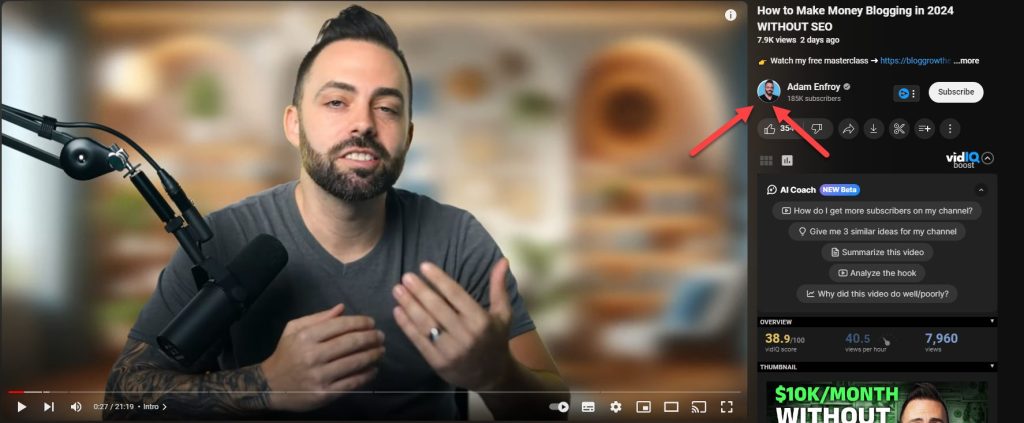
Hit “Upload” to upload a profile picture from your system. You can adjust the size of your image and click “Done,” and then click “Publish.”
There are specific criteria that your profile picture should meet, including:
- It should be a JPEG, GIF, BMP, or PNG file. It shouldn’t be an animated GIF, though.
- It also needs to be a minimum of 98 x 98 pixels. But YouTube’s recommended size is 800 x 800 pixels.
- The maximum file size should be 4 MB.
Banner Image.
Your banner image will only appear across the top of your channel. However, it’s an essential part of your channel since it gives viewers a visual sense of your channel and content.
Your cover photo should have these essential elements:
- A solid value proposition.
- The color scheme that matches your brand.
- Links to your other social networks, blog, landing page, etc.
Here’s how I incorporated my branding colors and my value proposition in my YouTube banner:

Also, remember that your banner image will appear differently on desktops, mobile devices, and TV displays — larger images may get cropped. YouTube recommends at least 2048 x 1152 pixels with an aspect ratio of 16:9 and 6MB or less for optimum results.
Video Watermark.
YouTube watermark is a graphic logo that contains the channel name, name of the video, or any other information related to the channel.
It appears at the bottom right corner of all uploaded videos and also during live streaming. Users can even use it to subscribe to your channel.
You just have to upload the watermark, just like your profile picture and banner, and then hit the “Publish” button. However, you’ll have to choose your display time before hitting the publish button.
You can display your watermark at either of the following display time:
- At the end of the video: Displayed for the last 15 seconds of the video.
- Custom start time: It will begin showing at any time you choose.
- Entire video: Displayed throughout the whole video.
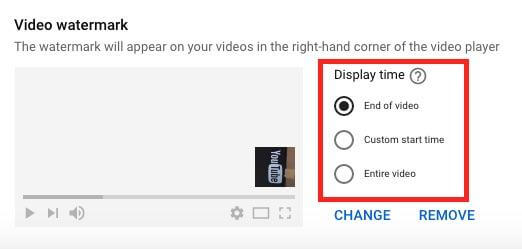
Also, YouTube suggests that the watermark should be a minimum of 150×150 pixels and less than 1 MB in size.
You can use Canva to create all your branding elements or any other free or paid photo editing services available online.
3. Customize YouTube Channel Layout.
Finally, let’s dive into the “Layout” tab that allows you to select and organize what viewers see when visiting your channel.
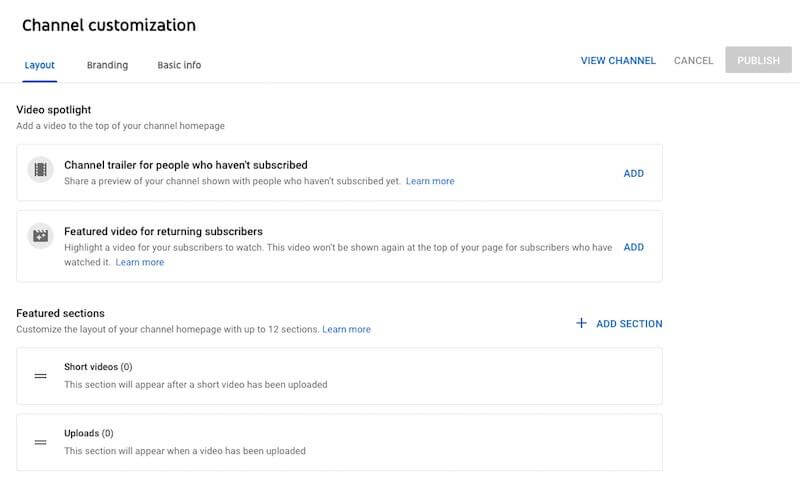
First, you can add a Video Spotlight. This is the main video users see when they first open your channel.
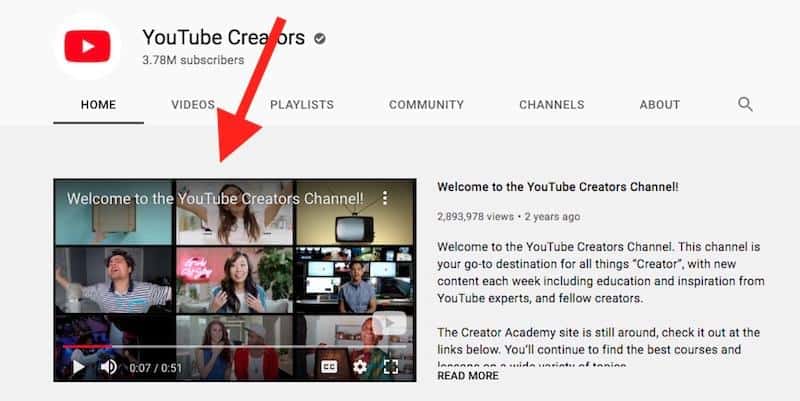
The Video Spotlight section lets you showcase two types of videos – depending on if the viewer is a subscriber or not.
For people who aren’t subscribed, you can add a channel trailer.
Your channel trailer should:
- Highlight what you create.
- Specify what viewers can expect from your channel.
- Encourage viewers to subscribe.
For returning subscribers, you can add any featured video.
You can change or remove these videos at any time by pressing the 3-dot menu.
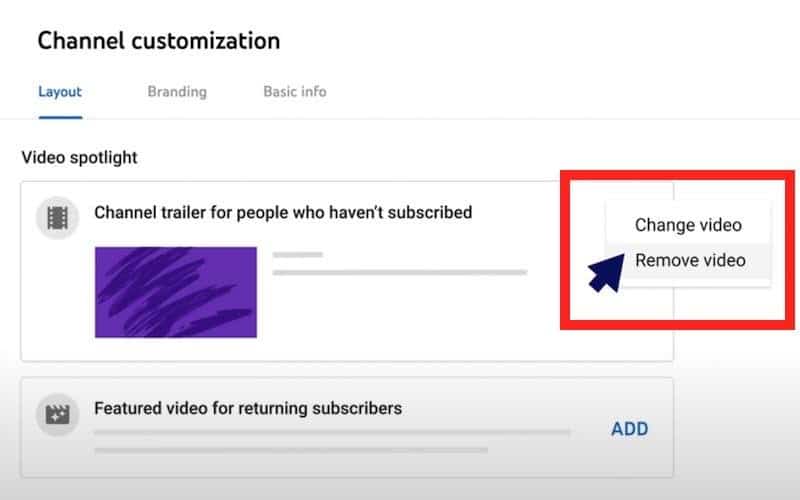
Next, you can add featured sections.
These featured sections allow you to customize what viewers see when they land on your channel homepage. You can categorize videos and playlists in different departments (or sections) for better visibility.
Here’s how YouTube uses multiple sections to group their videos, making it easier for subscribers to find videos based on their requirements and interests.
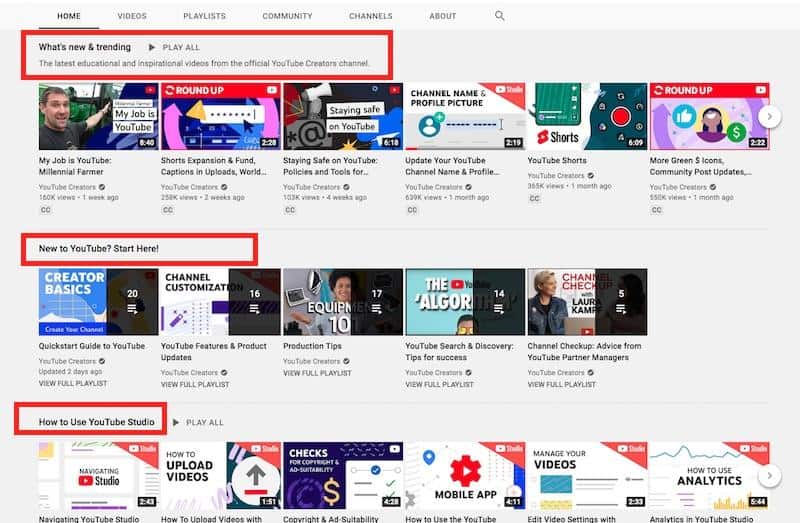
These are some of the sections I have on my channel:
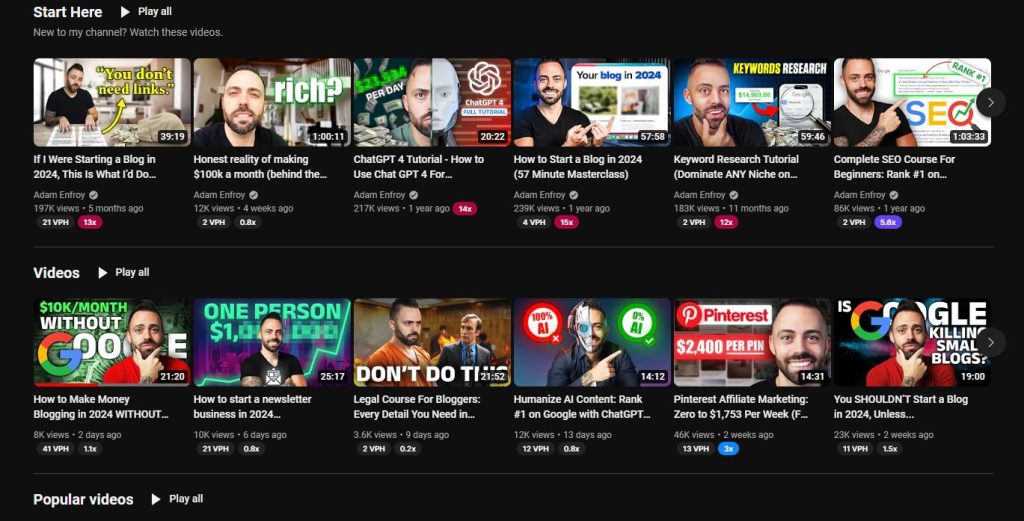
To add a section, click “Add Section” and then choose if you want to feature videos, playlists, or channels.
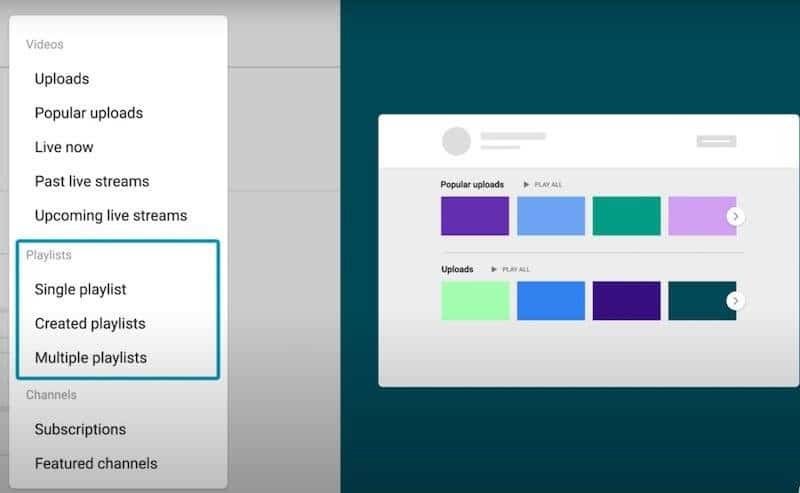
With Videos, you can choose from a list that will automatically group and pre-populate videos for you.
For instance, “Uploads” will automatically add any new video that you upload to your channel. Likewise, “Popular Uploads” will automatically showcase your top 12 videos with the highest views. And so on.
With Playlists, you can highlight already curated by you or other creators.
Finally, Channels let you showcase your collaborators or other channels.
YouTube lets you add up to 12 sections on your channel homepage.
This structure helps organize your content, so viewers don’t feel overwhelmed by the massive amount of videos you produce. It also gives you a chance to repurpose older content by grouping it with new content that you’ve created.
Make sure you leverage these sections to break down your videos and declutter and organize your channel to display it in the best light. I especially recommend it if you have a lot of videos on your channel.
Create Video Content: The Main Part of Starting a YouTube Channel
Now that you’re ready with your channel, it’s time to create engaging video content.
It’s straightforward to upload content on YouTube. But creating content that will get viewers hooked and lead them to watch your other videos is the real challenge.
But you need to consider a couple of factors before producing video content, starting with identifying your audience and choosing the type of videos you intend to create.
Identify Your Audience.
According to Statista, YouTube has about 2.3 billion active users worldwide – making it the largest user-generated video-sharing platform online.
With YouTube’s audience size, you can expect an extensive and diverse targeted demographic for your video content.
Don’t be intimidated by the potential reach of your videos. The key to finding success on YouTube is not trying to get everyone but rather targeting a smaller group and getting them to like and share your content.
You have to identify your target audience and what type of information they expect from you. It helps you develop better video topics because now you can directly target your viewers with your ideas.
For example, I create content for marketers and millennials. They are the ones who read my blogs and utilize my course to grow a sustainable blogging business.
If I try to be more specific, I’d say my target audience consists of beginners, marketers, affiliate markers, and users looking for a passive income.
The more you narrow down your niche, the easier it will be to resonate with your viewers.
Determine What Your Audience Expects From You.
You don’t want to get caught creating content for your audience that is not relevant to them, or worse yet, simply falls flat.
You have to determine their primary goals first. Are they tired of their unrewarding jobs and want to build some passive income? Or are they looking for parenting advice? Maybe they want to lose weight?
Ideally, your viewers’ goals will align with your product or service. However, it’s still best to determine their precise goals and create content catering to those goals.
When you create tailored videos to address a specific set of viewers, they will also subscribe at a faster rate. They’ll also keep coming back to your channel, helping you gain more momentum and views on your channel.
Pick The Video Type.
By now, you know who your target consumers are and what information they expect from you. Now you need to determine how they want to consume this information.
Sure it’s going to be in the video form, but what type of videos?
Here are the most popular types of YouTube videos:
- Product Reviews.
- How-Tos/Video Tutorials.
- Educational.
- Interview.
- Narratives.
- Reactions.
- Q&As.
- And more.
For example, I usually create video tutorials and talk about my strategies since my channel aims to give tips on “how to create and grow your blog.”
Choose The Best Equipment.
Equipment depends on the type of video. For example, an unboxing video or a casual vlog can be just an iPhone held in your hands and talking through it.
If you don’t want to spend much on equipment, get started with your smartphone videos for now. You can upgrade later based on your success.
But you need additional equipment to create high-quality youtube videos (like a tripod, shutter release, lighting, software to edit videos, etc.)
Here’s a list of the major equipment you need to create quality content:
Camera for Filming.
Your camera is going to be your number one asset. You can use a simple point-and-shoot camera to shoot quick videos in HD and DSLR cameras for a more cinematic and professional look.
Microphone for Audio.
While viewers sometimes don’t mind low-quality lighting, they cannot stand the low-quality sound. So if you’re using your camera’s or system’s built-in microphone, ensure you’re staying between three and four feet from the camera at most.
And if you want to get any further away from that, you need more advanced options, such as a shotgun microphone with directional recording. This means, whatever your microphone is directly pointed to, it’s still going to pick up your voice.
If you want a much wider shot, you might require a wireless lavalier microphone or a “lav.” It’s pricier than a regular microphone, but it’s convenient if you need to be far away from the camera.
Lighting.
A simple change in lighting can have a profound impact on the quality of your video. When you shoot YouTube videos in poor lighting, you end up with a low-quality video.
Most creators use a two-point lighting system.
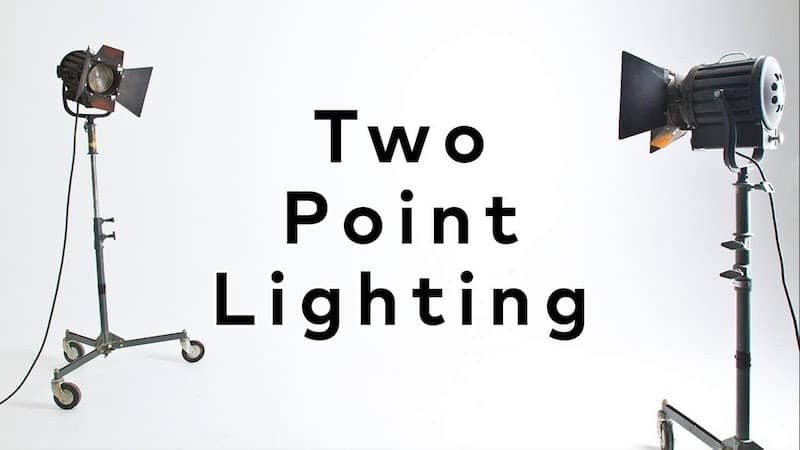
However, it’s going to be costly and consume more power. You might also get hot yourself with the two soft boxes lighting your face.
Some great alternatives to the two-point lighting system are LEDs or fluorescent bulbs.
Another option for soft, flattering light is a ring light. The ring light works really well to light up your whole face and give you that pop of eye light.
You can also consider camera-mounted lights or shooting in natural daylight.
Video Editing.
Video editing is the backbone of the YouTube industry. It doesn’t matter whether you are a beauty guru, gamer, or political commentator – creating video content will always require some kind of editing.
Take make it easier for you to learn I created a guide for how to edit YouTube videos so that you can make your videos even more engaging.
There are tons of video editing software out there to choose from. If you’re just beginning, you can use services already available on your computer. For example, you might already have iMovie if you’re on a Mac or Windows Movie Maker if you’re on a PC.
Focus first on learning how to do a simple cut to cut together your favorite pieces of footage. You can then learn how to use transitions, music, or even effects.
Prepare a Script For Your First Video.
Planning the entire process can add lots of stress to your life. The secret is to plan and prepare your script before you hit record.
For the best results, write a script or outline for your video. This will keep a general overview of what you want to tell your audience while on camera, thus reducing the likelihood that you will go off-topic.
Your YouTube script should consist of the following elements (in this order):
- An opening shot.
- One or two lines, setting up the scene.
- The problem you want to solve for your audience.
- Other information you will relay.
- The tone of relaying information.
- Any other helpful information.
Another necessary component of your script is a call to action. You want to push people toward taking that extra step necessary for you to close the deal.
Tips to Create YouTube Videos.
YouTuber or not, you’re still a content creator.
Just as bloggers and podcasters need to create compelling content, YouTubers also need a strategy to become successful on the platform. You need to produce stand-out videos that capture your audience’s attention and keep them glued to the screen.
Here are quick tips to make your YouTube videos more interesting:
1. Use Graphics in Your Videos.
A well-produced video can capture an audience’s attention while conveying an important message, but there’s a limit to how much your words can accomplish on their own.
And that’s where video graphics come into the picture. Adding graphics will help you add a visual element to your video to enhance your viewers’ experience.
Graphics in your videos can be logos, intros, lower thirds, buttons, transitions, and more. They’ll help you break up the scene and engagingly illustrate ideas.
You can use sites like iconfinder.com to find free icons and graphics to incorporate in your videos.
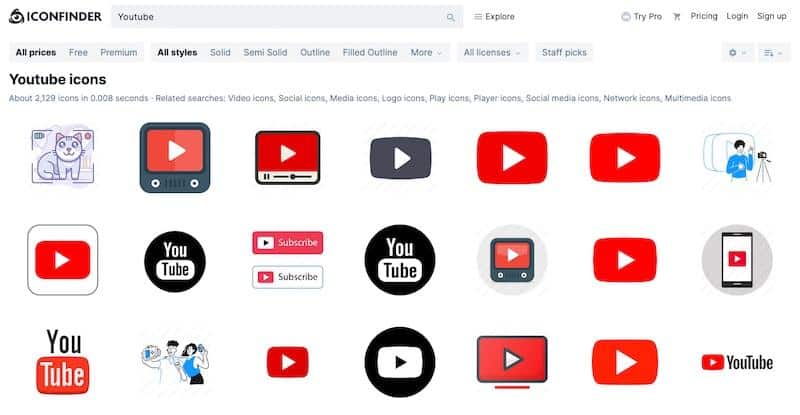
Music is another essential aspect of a YouTube video. It sets the mood, engages emotion, and draws your viewers into your video. Plus, it can add excitement to your intros, outros, and other parts throughout your video.
2. Create Call-to-Actions.
Whether you’re a small business owner, blogger, political candidate, or just making YouTube videos for fun and entertainment, call-to-actions are an essential part of increasing your conversions.
The best is that you can add clickable CTA overlays to your YouTube videos, prompting users to subscribe to your channel, social media platforms, redirect them to your other videos, get them to your website, and more.
And if you don’t want to distract your viewers with pop-ups during the video, you can place CTAs in your video description box.
For example, rather than placing CTAs during my video, I subtly bring notice to my CTA in the description box at the end of my videos.

3. Create Eye-Catching Thumbnails For Your Videos.
Creating thumbnails for videos is one of the best ways to get more views and engagement with your content. Often, users choose what to watch based on thumbnails alone. This means that your thumbnail image needs to be just right to get clicks.
After you upload a video, you get to choose from three automatically generated thumbnails or upload a custom thumbnail.

According to YouTube, 90% of the best-performing videos on YouTube have custom thumbnails. However, you can only get the ability to upload a custom thumbnail only if you have a verified account.
While creating a custom thumbnail, ensure that your thumbnail is high resolution – at least 1280 x 720 pixels. It should also have an aspect ratio of 16:9 and be under 2MB. Potential viewers are unlikely to choose a video with a blurry thumbnail.
Using high-contrast images with lots of depth will attract attention from afar. At the same time, an intriguing picture will pique people’s interest.
Another good practice is to use your titles and thumbnails in tandem.
For example, this intriguing combination of the title that says “This is Not Yellow” and an entirely contradictory thumbnail raises eyebrows and compels users to watch the video.

I make sure to add my face and/or my logo and specify what the video is about with text overlays. Note that the text overlays are giving a quick sneak peek into video content.

In addition, make sure your thumbnails are distinct, have your branding colors, and keep the text readable on all screen sizes.
While a good thumbnail can draw attention to your video and make it stand out by creating curiosity among viewers, you also need to take care not to overdo it.
You don’t want your thumbnail to be too flashy or misrepresent what you’re making just for the sake of views. A viewer who clicks on your video and feels tricked afterward is unlikely to stick around for long.
4. Create Compelling Titles.
You only have seconds to make an impression on people that see your YouTube video. A title that presents the information clearly and allows search engines to understand what the video is about will help you do just that.
While you don’t need to provide the entire plotline in the title, you do need to include some keywords if you want your video to be found. Finally, add a bit of intrigue to the title, and you’ve got yourself a winner.
5. Prepare Your Video Intro.
A good video intro, much like the opening credits of a movie, can significantly impact a video. The right video intro can instantly set the tone of your video and help your brand stand out.
It doesn’t have to be super long. In fact, it’s better to avoid making it long, or you might end up losing your viewers. According to Canva, your video intros shouldn’t be more than 10-15 seconds.
Other ingredients to the recipe of neat video introductions include informative text, vivid pictures, and well-composed background music.
Or you can skip all these bells and whistles and create an intriguing opening to hook in your viewers.
If you are creating a how-to video, there are good chances that the viewers especially searched for a specific keyword and clicked on your video. It’s not a chance visit.
In that case, you can also start with a simple intro and explain what you’re going to teach in the video and how viewers can benefit from it.
For example, I start this video with a quick opening like: “Hey guys, it’s Adam from Adamenfroy.com. In this video, I’m going to dive into Ahrefs and how to find keyword opportunities in any niche if you’re a blogger.”
How to Do Keyword Research with Ahrefs (Guide for Bloggers)
I usually follow this approach for my intros since most of my videos are tutorials and how-tos, where I teach viewers how to get things done in the blogging space.
Finally, Upload Your First YouTube Video.
We’ve looked at how to choose a topic, what equipment you need, and other handy tips for creating great YouTube videos.
Now it’s time to upload your videos on YouTube. There are two approaches to uploading your first YouTube video. You can either Live Stream on YouTube or upload a video file.
Head to YouTube Studio and then click on the “Create” option from the right-most section of your screen.
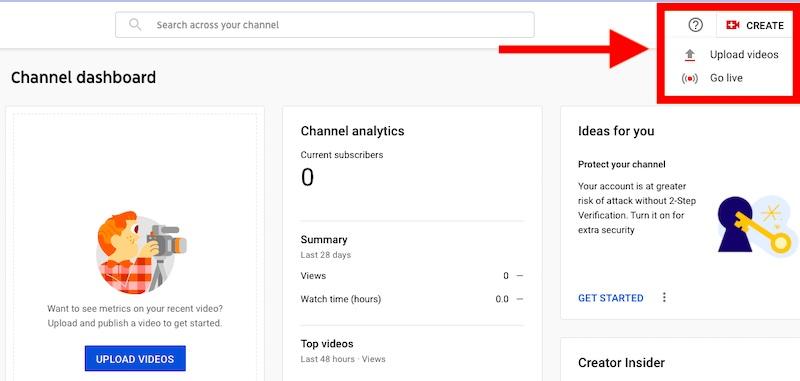
Hit the “Upload Video” button to upload a video from your system. You can choose to upload one file at a time or upload multiple videos at once.
After uploading the video, you can close the upload screen at any point, and your video will get saved automatically as a draft on your Videos page.
From here, you’ll get prompted to add a title, thumbnail, and description for your video. You can also add it to a playlist and set your video’s audience.
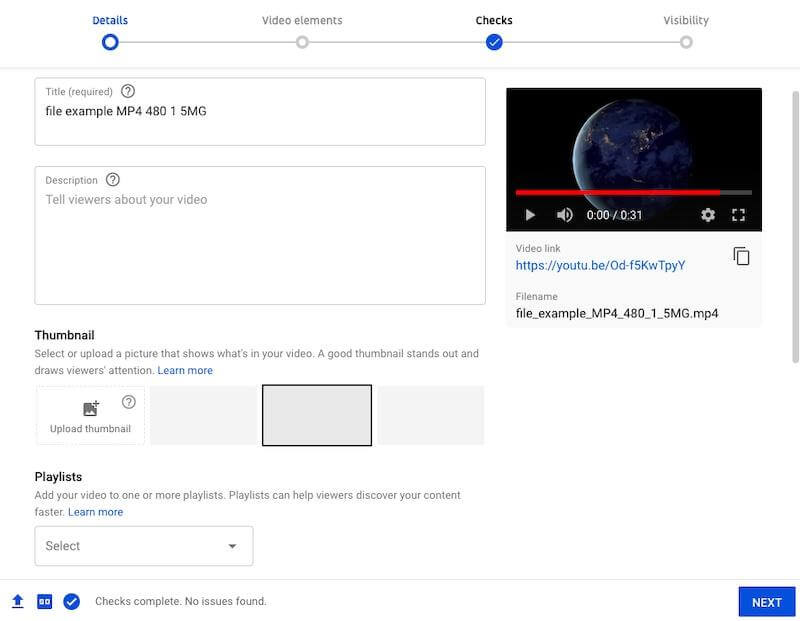
Make sure to follow YouTube’s Terms of Service and Community Guidelines. And avoid violating others’ copyright or privacy rights.
You can also find additional settings by clicking on the “Show More” option.
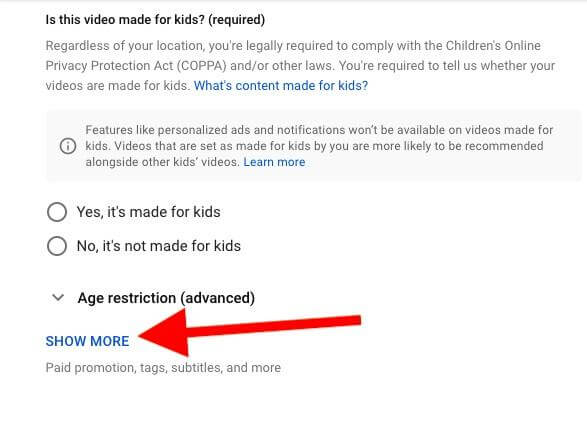
Additional video options allow you to add the following details:
- Paid Promotion – Select the checkbox if you accepted anything of value from a third party to make your video. YouTube will make users viewers that your video contains paid promotion.
- Tags – Tags are like descriptive keywords that help your videos get discovered more easily on the YouTube search engine. However, YouTube states that they don’t play an active role in your video’s discovery.
- Language and Captions Certification – Select your video’s language and, if needed, a caption certification.
- Category – Add your videos to a specific category to get discovered more easily.
- Comments and Rating – Choose if and how you want to show comments.
Click “Next” once you add these details.
If monetization is enabled on your channel through the YouTube Partner Program, you’ll get redirected to the “Monetization” section next.
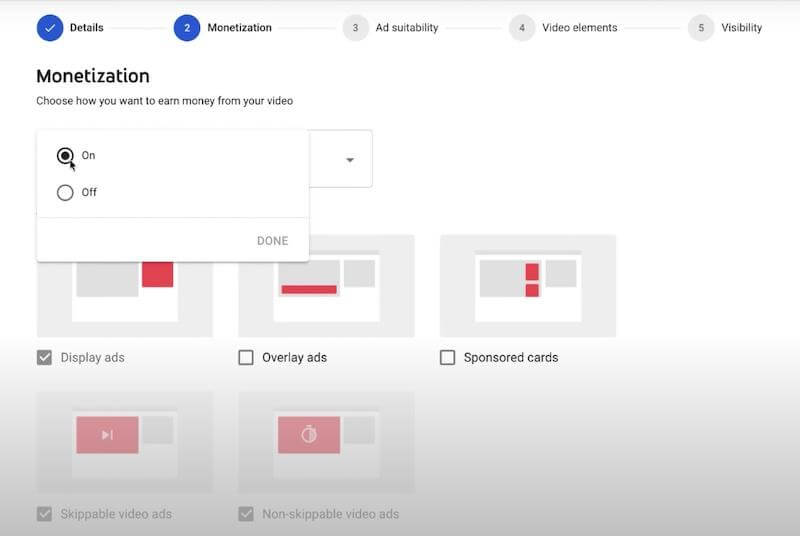
You can choose to turn monetization on and off for specific videos. If you decide to turn your monetization on, fill in your ad settings.
Next, you can add different video elements, such as subtitles, end screens, and cards to show viewers related videos, websites, and calls to action.
Finally, you can choose to make your video private or schedule it for a future date and time under the “Visibility” section.
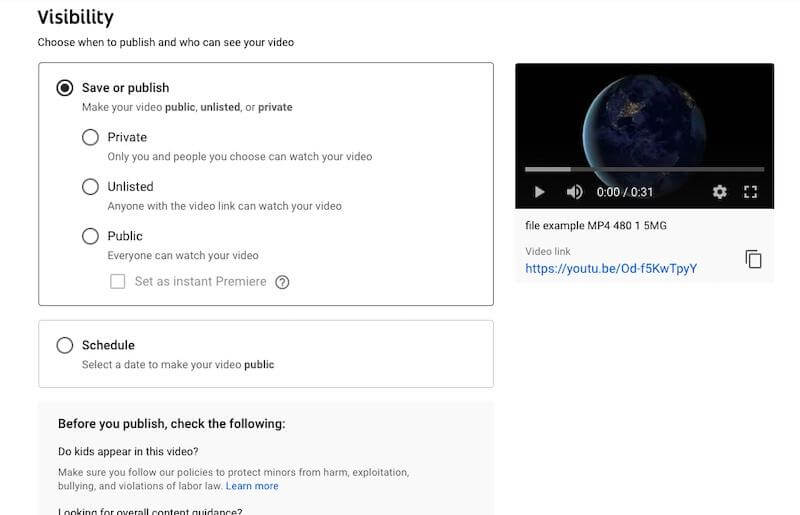
Click “Public” and then “Publish” if you want to go public immediately. You also have premier options: instant or scheduled. These might not apply to your use case but it’s good to know they exist.
You can now start sharing your video on multiple social media channels directly from YouTube for more visibility.
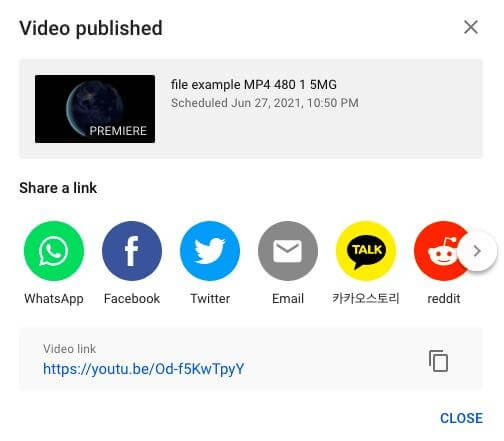
Grow Your YouTube Channel and Audience.
Setting up your YouTube channel, customizing your channel’s layout, and creating videos are just the first few steps in building your YouTube audience.
Now, you have to engage your audience and promote your channel to grow your subscriber base.
Here are some great tips to help you on your way to growing your YouTube channel:
1. Optimize Videos For YouTube Search and SEO.
Optimizing your YouTube videos is an easy way to drive targeted traffic from YouTube and other search engines.
Search engine optimization (SEO) and YouTube search ranking are two sides of the same coin.
Most people think that if they make a video, it will automatically rank in YouTube search results if they have enough views. This statement is not entirely false because it does happen occasionally, but there’s a lot more to it than just uploading random videos.
The most critical factors of optimizing a YouTube video for search engine visibility include:
- Your Video Title
- Video Description
- Tags
- Category
Good titles and descriptions are essential to make viewers decide whether they want to watch your videos or not. Descriptions also let YouTube’s algorithm determine what your video is all about.
When it comes to Video Description, first, you should briefly explain what viewers can expect from your video.
Ensure to put the most convincing part of your description and important keywords above the fold (towards the beginning of the description) since they’ll also appear in the YouTube search.
See it in action:

Next, you can encourage them to subscribe to your channel, check out other videos, or follow you off the platform.
Now, you can add all sorts of information after the “Show More” button. For example, you can mention your collaborators, add a table of content breaking down your video, list products you used in the video, and more.
You can add anything that provides value to your viewer and helps you direct them towards an intended action.
Your video description should perform like a resume that sells your videos, or even better, it can push views into quality leads and sales.
In addition, incorporate keywords you want to rank without appearing forceful or spammy. You can use Google Trends and the Keyword Planner to identify popular keywords.
2. Add Closed Captions.
Closed Captions on YouTube can attract a more relevant audience, increase watch time, and improve the overall visibility of your videos.
You either add captions automatically or manually from YouTube Studio >> Subtitles tab.
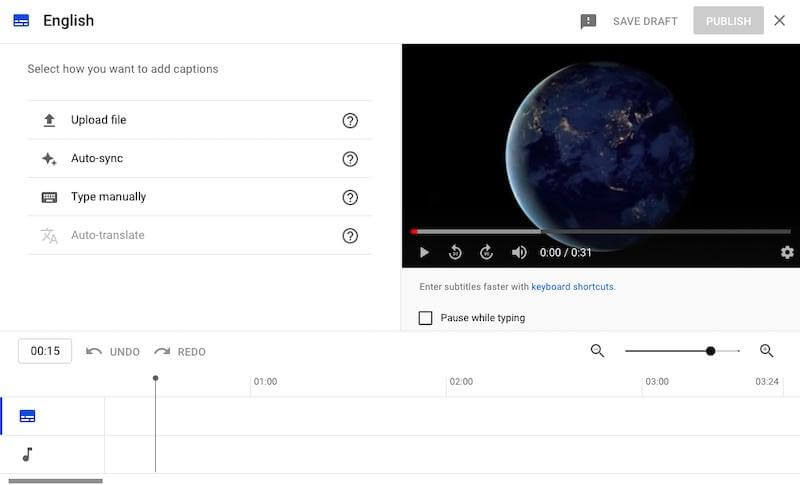
Note that to use auto-translate, publish captions in the original video language first. The auto-translate option is unavailable for auto-generated captions.
You also have the option to use third-party closed captioning software to generate a more accurate transcription of your video. From there you can upload the file directly to YouTube.
3. Promote Your YouTube Videos Via Email.
There are many ways to promote your video, like sharing it with influencers or posting on Facebook. Another excellent method for promoting your video is email marketing.
According to statistics, incorporating videos in your email can increase click rates by 300%. That’s why it should also be part of your YouTube marketing strategy.
Begin by writing an email copy that describes the topic of your video. Then, tell them how you’re going to help them, and then finally, link your video.
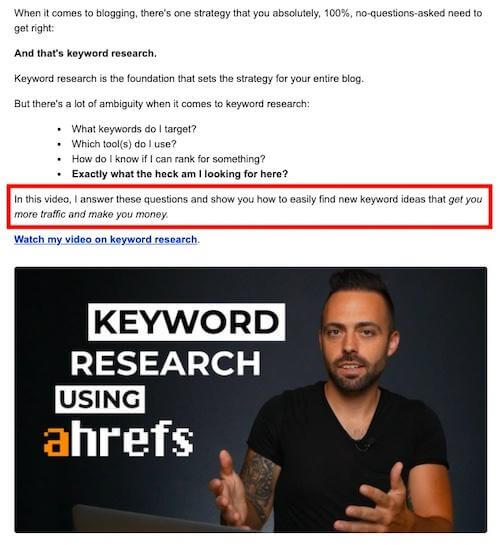
This will help you receive a lot of views, comments, and shares on your YouTube video. However, this technique only works when you already have a significant number of email subscribers.
4. Run Paid Ads On YouTube.
Running a paid YouTube ad campaign is an excellent way to reach potential viewers where they’re watching.
While you may prefer to promote your content organically, ads can be lucrative initially if you have no audience yet.
Although your ad will get placed on YouTube, you’ll build and manage your ad campaign using Google Ads.
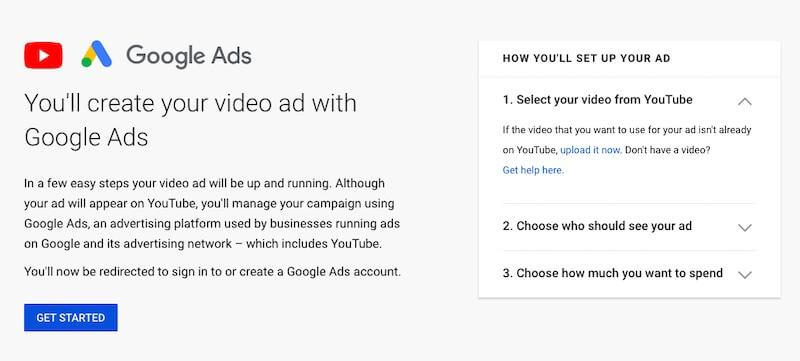
You just have to follow a step-by-step process to place your ads directly in front of your target audience.
5. Incorporate Keywords in Your Titles/Descriptions.
YouTube Keyword research will allow you to find out the most relevant keywords people use in YouTube to search for your type of video. By doing so, you can rank your videos for the most profitable searches.
One way to start your YouTube keyword research process is through YouTube’s search suggestions.
You may encounter a few YouTube search suggestions for specific keywords on YouTube. These suggestions get generated because people often search for these terms on YouTube.
Begin by entering a relevant phrase you want to create your video around in the YouTube search.
“YouTube’s Search Suggest” functionality will then help you discover relevant keyword phrases users are typing into YouTube.
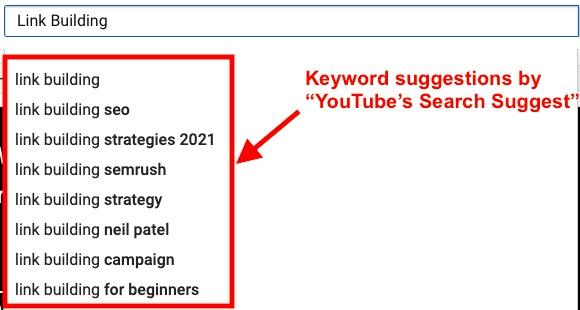
These are all trending keywords you can rank for since YouTube itself is suggesting them.
Another way to identify relevant key phrases is by heading to another channel in your niche.
Navigate to their videos sections and sort videos by popular videos.
For example, you can head to Marques Brownlee’s channel (a popular tech YouTuber) if you are a tech YouTuber.
Here are some of his most popular videos:
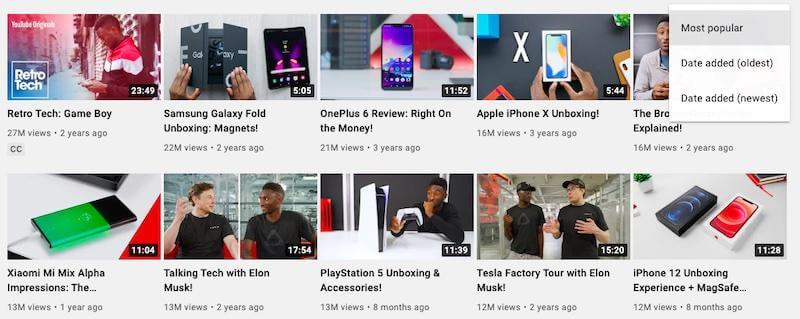
There are good chances that these videos are created around the most searched phrases and content in your niche.
Finally, you can pick videos from the list and create similar content around them. You might also want to check out their descriptions, titles, and tags and see which keywords they revolve around.
I also suggest using VidIQ to get more relevant search term suggestions and discover trending videos in your niche.
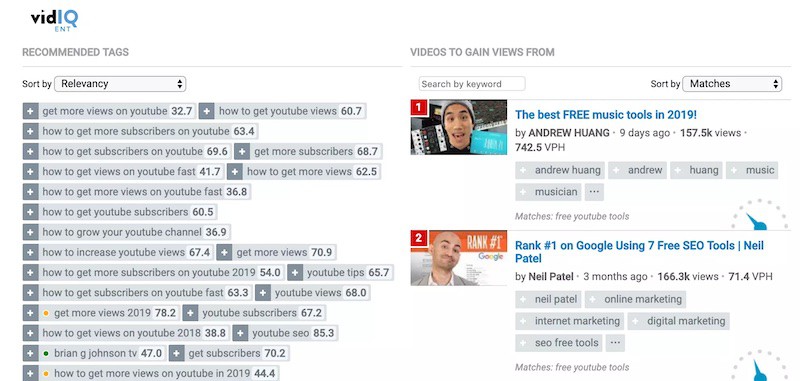
It also provides insights into metrics like competition score, search volume, and more to discover the most profitable keywords.
6. Boost Your Retention Rate.
Ultimately, high retention YouTube videos will rank higher than those with low retention. And to retain viewers, you have to spike their interest and keep them interested till the end of your video.
Other than retention rate, here are other ranking factors you need to consider:
- Comments on your video.
- Subscribers.
- Video shares.
- Click-through-rate.
- Likes/Dislikes on your video.
Again, most of these factors require you to spike your viewers’ interest. If they like your content and find it interesting, they’ll eventually perform all of these actions.
Entertainment, celebrity, comedy, drama, or how-tos, and tutorials – your video should involve either of these elements to engage viewers. You can also consider mixing two or more of these elements to make your videos more powerful.
7. Post Videos Consistently.
YouTube is a way to reach out to new people in the world. Although you have to make sure you’re consistent about making videos so people can get attached to your channel.
If you don’t post at least one video per week, you might end up losing viewers and subscribers. Not posting regular videos will also result in failure to attract organic traffic from the search engines.
It’s worth noting that PewDiePie (the biggest YouTube channel) uploaded videos almost every day for ten years. Even after blowing up on YouTube and finding unparalleled success, he continues to upload videos multiple times a week.
We all know the results. Today PewDiePie has over 110M subscribers.
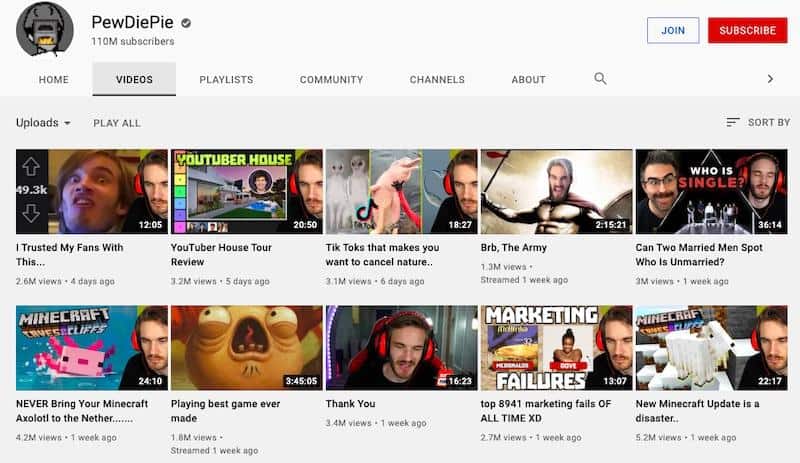
You can post miniature versions of tutorials or how-tos that revolve around a broader topic. This will also help you build a steady stream of an audience that will keep coming back for more tutorials.
This also results in building an active community and gaining more positive results on each new video.
8. Engage Your YouTube Audience Using Q&As.
One of the best ways to build a strong rapport with your audience is by initiating a live Q&A session on YouTube.
A Q&A session is an open forum where you invite your viewers to ask any questions they might have about your channel or brand.
You can then answer the questions candidly that makes your audience view you as personable and approachable.
Here are some other quick ways to build a successful YouTube channel:
- Mention your channel on sites like Reddit and Quora.
- Track important video metrics using YouTube analytics and optimize your videos subsequently.
- Host giveaways.
- Repurpose existing content into videos.
- Optimize your YouTube channel art (profile image, banner, thumbnail).
- Collaborate with other influencers in your niche.
Monetize Your YouTube Content.
There are plenty of opportunities for Youtubers to earn money on YouTube by monetizing their channels, ranging from selling branded merchandise to video advertising.
The best way to think of it is this:
Your YouTube description is like your “monetization box.”
You can add links to anything you want – affiliate links, links to your own products like a course, sponsors, etc.
When you mention in your video to click links in the description, people really do it.
Here are a few ways to make money through your channel:
- Earn advertising revenue from the display, overlay, and video ads.
- Do affiliate marketing. Partner with brands and promote their products/brands on your channel in exchange for monetary compensation.
- Sell your branded merchandise and display them on YouTube’s merch shelf.
- Encourage viewers to pay via Super Chat and Super Stickers during your live streams.
- Allow users to join your channel through recurring monthly payments.
How to Start a YouTube Channel – FAQ
Can You See Which People See Your Videos On YouTube?
Due to privacy policies, there’s no way to individually see who’s seen your videos on YouTube.
However, you can use a lot of data to create better videos that are targeted toward your ideal target persona.
Executive Summary.
Whether you’re helping customers shop for the best deal, promoting your affiliate links, creating deals of your own, or simply asking viewers to subscribe, your videos serve as a unique form of communication.
These videos can boost subscribers and sales—and they’re perfect channels to drive leads, shape opinions, and promote products to the right audience.
We’ve made it pretty far together. This guide contains everything you need to start a new YouTube channel. Now you need to follow this step-by-step process to create a channel of your own.





